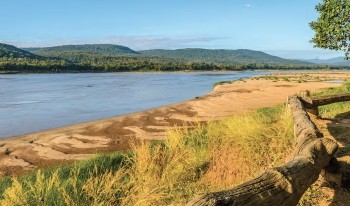Report
Monitoring the quantity of water flowing through the Upper Mekong basin under natural (unimpeded) conditions
April 13, 2020
Environment
This study developed a reliable and simple model that predicts the natural flow of the Upper Mekong, then used this prediction to determine how the cascade of dams built on the Upper Mekong is altering the natural flow of the river. The foundation of this study is based on satellite data from 1992 to 2019 and daily river height gauge data from Chiang Saen, Thailand. Eyes on Earth, Inc. and Global Environmental Satellite Observations, Inc. have developed proprietary software, which is based on an algorithm that translates microwave observations measured by the Special Sensor Microwave Imager/Sounder (SSMI/S) into a land surface wetness index. Using the model to predict natural flow, we calculated the quantity of water that would naturally flow versus the measurement at the Chiang Saen gauge. This difference was summarized over various periods of the 28-year record to identify the amount of water that is either impounded in the reservoirs or extracted from the river basin upstream of Chiang Saen by other means.
Currently, 126.44 meters of river height is missing at the gauge in Chiang Saen over the 28-year record. Huaneng Hydrolancang, a Chinese state-owned enterprise, built a series of dams on the main stem of the Mekong during that time. There is generally a good correspondence between the gauge measurements and the satellite-derived estimates during the early years, with some deficiency in river height during the filling of the Manwan and Dachaoshan reservoirs. The relationship between gauge height and natural flow deteriorated after 2012, when a couple of major dams and reservoirs were built, which greatly restricted the amount and timing of water released upstream. The Government of China has pledged to utilize these dams to regulate downstream flow so that period of high and low flow would be more evenly distributed. This also suits their need to distribute the energy production across the annual cycle, allowing the generators to be used more equitably throughout the year. The consequence of flow regulation is that water that would normally flow during the wet season is released during the dry season.
This can clearly be seen in the annual cycle of the residuals, which are negative in the wet season and positive in the dry season. When the largest of the dams, Nuozhadu, and its reservoir were completed, the lack of water during the wet season is most pronounced after the largest generators began operating.
The dams greatly expand institutional capacity to regulate the river flow, with corresponding impacts downstream that need to be addressed through holistic solutions. The six dams built since the commissioning of the Nuozhadu Dam in 2012, are compounding the alteration of natural river flow as the reservoirs are filled and water is released. One of the greatest consequences occurred in 2019, when the Lower Mekong recorded some of its lowest river levels ever throughout most of the year. Using the wetness index to predict natural flow, it is evident that there was above-average natural flow originating from the Upper Mekong. The residuals demonstrate excess flow in the dry season, presumably to support electrical produc-tion in early 2019, while the flow during the wet season was severely restricted as the Lower Mekong received record lower levels of rainfall. The severe lack of water in the Lower Mekong during the wet season of 2019 was largely influenced by the restriction of water flowing from the upper Mekong during that time. Cooperation between China and the Lower Mekong countries to simulate the natural flow cycle of the Mekong could have improved the low flow conditions experienced downstream between May and September of 2019. If the wetness index is used as a guide to simulate natural flow, then all communities along the Mekong basin could benefit from maintaining the integrity of the Mekong River.
This work is licensed under the Creative Commons Attribution-ShareAlike 3.0 Unported License. To view a copy of this license, visit http://creativecommons.org/licenses/by-sa/3.0/ or send a letter to Creative Commons, 444 Castro Street, Suite 900, Mountain View, California, 94041, USA.
RELATED RESOURCES
Stay Updated. Subscribe Now.
Pact's e-newsletter offers the latest on our efforts around the world to build thriving, resilient and engaged communities that are leading their own development.
